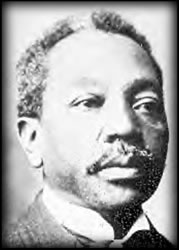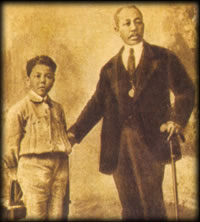By
Gabino Ezeiza, the payador of San Telmo

ome people will say it was José Betinotti, maybe others will mention Pablo Vázquez, Higinio Cazón or Nemesio Trejo, and even somebody will prefer Luis Acosta García or Andrés Cepeda; but out of that generation so special of itinerant singers that were heard between the late nineteenth century and the early twentieth century, only one would keep the condition of having been “the most extraordinary improviser” of his time for a long time after his death: Gabino Ezeiza, a representative of the Buenos Aires neighborhood of San Telmo.
 He was born in 1858, then we can say that he grew up at the time our republic was being organized; and he lived in a city that definitively was no longer a «Big Village» but was to become a true metropolis. In his later oeuvre we find a depiction of this so peculiar period of the Buenos Aires society, that politically saw the growth of the political parties and the parochial leaders, and culturally was changed with the presence of the immigrant, side by side with the native inhabitant.
He was born in 1858, then we can say that he grew up at the time our republic was being organized; and he lived in a city that definitively was no longer a «Big Village» but was to become a true metropolis. In his later oeuvre we find a depiction of this so peculiar period of the Buenos Aires society, that politically saw the growth of the political parties and the parochial leaders, and culturally was changed with the presence of the immigrant, side by side with the native inhabitant.
This is not the place to research either the origin or the details of the art of the payador (an itinerant singer that improvised his lyrics) but it is worthwhile to remember that around the last three decades of the nineteenth century this genre achieved an unexpected importance and succeeded in becoming part of the urban environment strongly and permanently. In this generation of payadores Ezeiza is included.
A lot of information in his biography is vague. The references about his ancestors are not certain; many sources have imagined them as proud slaves that were set free and who had lived their time of splendor before the battle of Caseros.
The news about his beginnings and his teachers are also scarce and poor. But a name, rather blurred, is remembered: Francisco Luna. The latter was identified or maybe mistaken with a dark-skinned man called Pancho who had an encounter for improvising sung stanzas with Santos Vega and was defeated. Active since the times of Rivadavia, this guy Luna worked as a rural tavern keeper and was fairly well-known at the «Barrio del Mondongo», a neighborhood located within the boundaries of the parish of San Telmo; apparently, he was the one who inducted Ezeiza into this art when, at the time of his retirement, the former gave his guitar to the latter.
Before 1880 he was already having contests and achieving victories. He was fond of contests that included questions and answers. There are funny testimonies of these events. One of them refers to a certain encounter in Lomas de Zamora in which someone in the audience suggested metempsychosis as a subject matter (a religious doctrine according to which after death the soul begins a new cycle of existence in another human body). Ezeiza solved it ingeniously: «To the one who metempsychosis brought/ I answer in a way not ordinary/ I answer in a way not ordinary/ Why on earth when he had this thought/ he didn’t send me a dictionary?»
Crafty answers like this one will be his big success. Like every payador, he was aware that his ability did not consist of a florid language or a rigorous observance of the rules of poetry, but he knew that his success depended on a quick and smart answer.
Another example, when the caricaturist José María Cao demanded him to improvise on the logarithm: Ezeiza asked for permission, went to the house of a professor he knew and returned later ready to improvise on this new knowledge: «Gentlemen, I’m bound to explain / the science of logarithm, / if I am right in the rhythm / of my simple way to say. / To begin let us now place / two progressions, an exponent / a difference and a quotient / that corresponds to each other / and damn it! From here you’ll gather / a system to surprise, men...»
In 1884 he held a contest in payada with Nemesio Trejo, for raising funds for the victims of the floods in Barracas. The chosen form was the milonga; Ezeiza crowned his show by describing in verse the city of Montevideo. But he reached the climax when by accident one of the strings of his guitar broke. In a display of his fast thinking, Ezeiza compared that broken string to his own feelings.
Appearing in theaters and in local circuses (and as well in societies and political party locals), Ezeiza was forging a dexterity that was envied and feared. Among his most well-known challengers people remember Félix Vega, from El Tuyú; Ramón Barrera, from Dolores; and his most feared rival: Pablo J. Vázquez, from Flores. With the latter he held a dangerous contest in Pergamino which started on October 13, 1894 and lasted two nights. A stenographic transcription of this encounter has survived in which Ezeiza spurred Vázquez by saying: «Some people a story once threw / that I was completely dead / but now you can really guess / that such a story’s not true».
 However, Ezeiza used to remember Florencio Constantino, a tenor singer of a renowned career at the Teatro Colón as from 1909, as a great opponent in these sort of ad lib singing. Even though he was labeled as an operatic singer and there is almost no record of his career as payador, Constantino improvised in a style quite close to Ezeiza’s; and the latter would not hesitate to say that the then tenor singer «was to be feared» in that field.
However, Ezeiza used to remember Florencio Constantino, a tenor singer of a renowned career at the Teatro Colón as from 1909, as a great opponent in these sort of ad lib singing. Even though he was labeled as an operatic singer and there is almost no record of his career as payador, Constantino improvised in a style quite close to Ezeiza’s; and the latter would not hesitate to say that the then tenor singer «was to be feared» in that field.
Ezeiza had a contest with Juan De Nava in Uruguay; it was then when his song “Saludo a Paysandú” was born. It was also called “Heroico Paysandú” because of its first line. He composed it only to ingratiate himself with an unusually hostile audience. (As Ezeiza also contested with Arturo De Nava, Juan’s son, when this episode is mentioned their names are frequently mistaken). But this piece long lasted to his own surprise because he admitted he lacked literary abilities: even towards 1911, when he was long ago one of the favorite artists of the audiences in Buenos Aires, in an interview for the P.B.T. magazine he confessed that he had no capabilities as writer.
In the twenties, and after over five years after Ezeiza’s death, this song was still in the songbook of many singers. The Gardel-Razzano duo recorded it for Nacional discs in 1922; its verses were still popular: «Heroic Paysandú, I welcome you / because you are the American Troy; /I welcome this people of brave men / and the birthplace of the brave Thirty-Three».
But the truth is that not only “Saludo a Paysandú” survived but also remained “El silencio de las tumbas”, “Él sabía”, “Mi caudal”, “Ella [b]” and some historical episodes like “El combate de San Lorenzo” and “Naufragio de la “Rosales” and, likewise the above cited poems, would be widely published in brochures. He also wrote, at least, two dramatic plays: “Lucía Miranda” and “El cacique Mangoré”.
When the Revolución del Parque (Revolution of the Park)(1890) took place he was a member of the Alem’s ranks. Because of that he was incarcerated and thereafter his enemies set fire to the Pabellón Argentino, a circus he had acquired thanks to a stroke of luck in the lottery. He took part in the uprisings of 1893, and many years later he would still proudly wear the medals with which he was awarded for his loyalty to Dr. Mariano Candioti and General Frías.
In 1895 Ezeiza married Petrona Peñaloza who belonged to the family of the murdered caudillo (leader) of La Rioja. Of the six siblings of this married couple, Fortuna, the eldest, since an early age evidenced excellent gifts as soprano singer. At their first domicile on Cuenca Street, and later not far from there, on Azul 92, the Ezeizas used to be regularly visited by the personalities of that time who were often accompanied by journalists, eager to hear the special talent of Gabino and be photographed with him.
As from 1905 the phonograph picked him up and made him last through the years. Because of that the lyric of the tango “Gabino” composed by Antonio De Bassi and Manuel Romero as a homage to him is inaccurate when it says «Gabino did not recorded his singing...» On the contrary, Ezeiza recorded and he did it many times for the Zonofono (discs that were recorded on one side only), Columbia Record and ERA labels. Of the latter, some numbers were published under other labels, such as Artigas.
Probably today Ezeiza’s voice brings a sort of disappointment if we are expecting some kind of virtuoso style or some uncommon resource. Approaching these records with the ears of a music listener would be a mistake. Its value is different: it is an audible document of a kind of artist that disappeared a few years later. A piece of information cannot be overlooked: besides his songs to the beat of milonga, cifra or other rhythms suitable for the payada, Ezeiza also composed, sang and recorded tangos, around 1905.
The invincible payador passed away on the same day that Yrigoyen assumed office as president of the nation. His remains rest in peace at the cemetery of San José de Flores. Héctor Blomberg remembered him in his milonga “El adiós de Gabino Ezeiza” with music by Enrique Maciel and committed to disc by Ignacio Corsini in 1933. In one of its stanzas he asked Buenos Aires not to forget him, but from time to time memory is fond of oblivion.